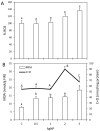Phytotoxic Action of Silver Nanoparticles on Lemna minor: Multi-Parameter Analysis of Different Physiological Processes
- PMID: 36679056
- PMCID: PMC9861787
- DOI: 10.3390/plants12020343
Phytotoxic Action of Silver Nanoparticles on Lemna minor: Multi-Parameter Analysis of Different Physiological Processes
Abstract
Considering the widespread use of silver nanoparticles (AgNPs) and their consequent build-up in waterways, there is a concern about the hazardous effect of AgNPs for aquatic ecosystems. The aim of this study was to clarify the mechanism of the action of AgNPs on duckweed (Lemna minor L.) by evaluating multiple parameters in different physiological processes. Duckweed was treated with AgNPs in a concentration range of 0.5 to 5 mg/L over a 7-day period. The analysis revealed that the AgNP-treated duckweed accumulated Ag in accordance with increasing AgNP concentrations. Furthermore, higher concentrations (2 and 5 mg/L) of AgNPs negatively affected N, P and especially K and Mg levels in the plant tissue. Accordingly, the plant growth and photosynthetic parameters were more inhibited in response to higher concentrations of AgNPs. Nanosilver significantly increased the generation of ROS at higher concentrations, although lipid peroxidation was significant even at the lowest concentration of AgNPs. However, defense mechanisms were able to counteract AgNP-induced oxidative stress and balance the intracellular redox status, as evidenced by increased activities of the main detoxification enzymes. With this experimental setting, AgNPs exhibited a relatively weak phytotoxicity at 0.5 and 1 mg/L; nevertheless, silver in a nano form poses a hazard for plants, considering its continuous release into aquatic environments.
Keywords: antioxidative enzyme; glutathione; malondialdehyde; nanosilver; photosystem II.
Conflict of interest statement
The authors declare no conflict of interest.
Figures



References
-
- Khan I., Saeed K., Khan I. Nanoparticles: Properties, applications and toxicities. Arab. J. Chem. 2019;12:908–931. doi: 10.1016/j.arabjc.2017.05.011. - DOI
-
- Lekamge S., Miranda A.F., Abraham A., Li V., Shukla R., Bansal V., Nugegoda D. The toxicity of silver nanoparticles (AgNPs) to three freshwater invertebrates with different life strategies: Hydra vulgaris, Daphnia carinata, and Paratya australiensis. Front. Environ. Sci. 2018;6:152. doi: 10.3389/fenvs.2018.00152. - DOI
-
- Cvjetko P., Milošić A., Domijan A.M., Vinković-Vrček I., Tolić S., Peharec Štefanić P., Letofsky-Papst I., Tkalec M., Balen B. Toxicity of silver ions and differently coated silver nanoparticles in Allium cepa roots. Ecotoxicol. Environ. Safe. 2017;137:18–28. doi: 10.1016/j.ecoenv.2016.11.009. - DOI - PubMed
Grants and funding
LinkOut - more resources
Full Text Sources

